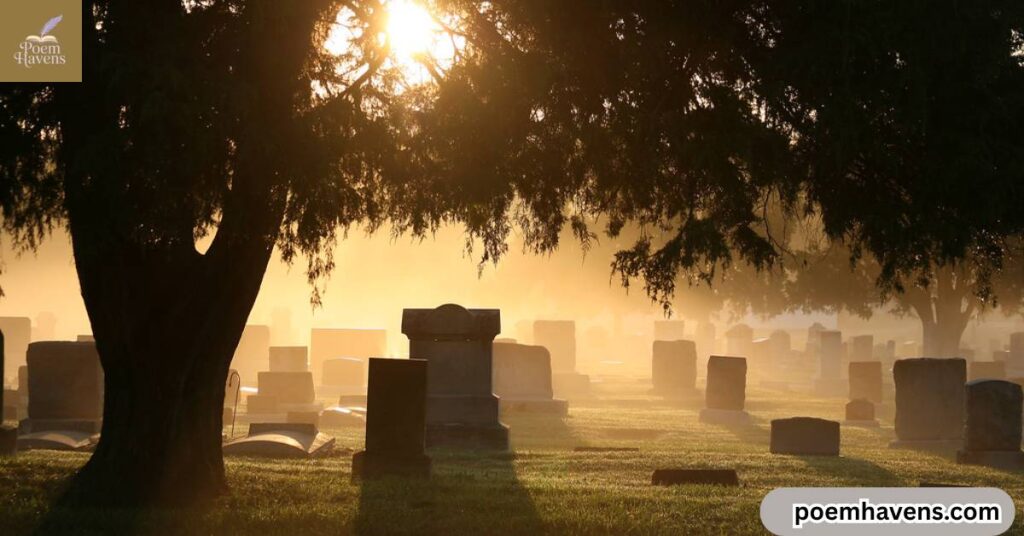When someone you love leaves this world, words often fail ,yet a single poem can speak for the heart. The Do Not Stand At My Grave And Weep poem by Mary Elizabeth Frye has done exactly that for nearly a century. Written with compassion and simplicity, it turns pain into peace and loss into light. This beautiful funeral poem reminds us that love never dies; it only changes form and continues through the gentle rhythms of nature.
In this article, you’ll journey through the poem’s deep meanings, history, and comforting message. From its mysterious origins to its spiritual insight, every line of the Do Not Stand At My Grave And Weep poem carries the warmth of eternal love. Whether you’re grieving or seeking solace, these verses will help you feel that no goodbye is ever final ,only transformed.
Origin and History of the Poem
The story of the Do Not Stand At My Grave And Weep poem begins in the heart of Mary Elizabeth Frye, an ordinary Baltimore woman with extraordinary compassion. In 1932, she wrote this piece for a young Jewish girl who couldn’t visit her dying mother’s grave in Germany.
Deeply moved by her friend’s sorrow, Frye penned these timeless lines on a simple brown paper bag ,words that would later travel across continents and generations.
Though Frye never sought fame, her poem spread organically, carried in letters, obituaries, and memorials. For decades, its authorship remained uncertain, sparking debates and misattributions. In 1998, The Times of London finally confirmed Frye as the true author.
Today, her grief poem stands among the most beloved funeral poems ever written ,recited at services, carved on memorials, and shared by hearts seeking solace in the face of loss.
Recommended Blog : Poem of Mourning – Finding Light in the Depths of Grief
Do Not Stand At My Grave And Weep Poem Text
Before diving into its deeper meaning, it’s essential to read the Do Not Stand At My Grave And Weep poem in its pure form. Every line carries a quiet reassurance that love transcends mortality and that the soul continues to live through nature’s endless rhythm.
Do Not Stand At My Grave And Weep
by Mary Elizabeth Frye
Do not stand at my grave and weep,
I am not there; I do not sleep.
I am a thousand winds that blow,
I am the diamond glints on snow.
I am the sunlight on ripened grain,
I am the gentle autumn rain.
When you awaken in the morning’s hush,
I am the swift uplifting rush
Of quiet birds in circling flight.
I am the soft stars that shine at night.
Do not stand at my grave and cry;
I am not there. I did not die.
This version is the most widely accepted and recited at funerals and memorial services. However, minor variations exist in punctuation and phrasing, reflecting the poem’s oral tradition and its journey across time.
Summary and Central Message
At its heart, the Do Not Stand At My Grave And Weep poem is a message from the departed to the living ,a tender whisper urging those left behind to let go of sorrow. Mary Elizabeth Frye transforms the idea of death into a continuation of life, showing that the soul doesn’t sleep beneath the earth but moves freely through the natural world.
The speaker becomes the wind, the rain, the sunlight, and the stars ,gentle reminders that love never truly disappears.
The poem about death and comfort offers solace to grieving hearts by replacing despair with hope. Instead of viewing death as an ending, it teaches us to see it as transformation ,a reunion with nature and eternity.
Every image Frye uses becomes a metaphor for immortality, reassuring mourners that their loved ones remain close, not in body but in spirit, woven into every element of creation.
Line-by-Line Explanation
“Do not stand at my grave and weep”
The poem opens with a gentle command ,not to cry or grieve at the grave. The speaker’s voice, calm and compassionate, reminds the mourner that death isn’t the end. It suggests that mourning only binds the living to sadness while the spirit has already found peace.
“I am not there; I do not sleep.”
Here, the grief poem breaks traditional notions of death. The soul doesn’t lie still beneath the earth but remains awake, alive, and present. Mary Elizabeth Frye conveys that life continues in a spiritual form ,an idea that comforts those who fear loss.
“I am a thousand winds that blow,”
The poet uses imagery of wind to symbolize freedom and movement. Wind is invisible yet felt everywhere, just like a departed soul. The line offers assurance that the loved one remains near, surrounding us in unseen ways.
Also Read This Blog : Poems About Nature: Beautiful Verses That Celebrate the Earth’s Timeless Wonders
“I am the diamond glinting on snow.”
This vivid image reflects purity and beauty. Snow sparkles under sunlight, representing the soul’s transformation into something eternal and radiant. It reminds us that even in the coldness of grief, there is light and grace.
“I am the sunlight on ripened grain,”
The sunlight represents warmth, nourishment, and continuity. Just as the sun gives life to the harvest, the soul continues to give meaning to the lives of those who remain. This is one of the poem’s most comforting metaphors of immortality.
“I am the gentle autumn rain.”
Rain here symbolizes renewal and healing. Autumn, often linked with endings, becomes a season of peace in this poem about death and comfort. The departed soul falls softly upon the earth, blessing it with tenderness.
“When you awaken in the morning’s hush,”
This line shifts from imagery of nature to a moment of quiet reflection. Morning represents new beginnings ,the calm after a night of sorrow. It invites the living to sense the soul’s presence in life’s everyday stillness.
“I am the swift uplifting rush of quiet birds in circling flight.”
The movement of birds symbolizes the spirit’s ascent. The funeral poem uses this image to capture freedom beyond physical limits ,a reminder that love rises and circles eternally, never lost, never grounded.
“I am the soft star that shines at night.”
Stars have always symbolized eternity and guidance. Even in the darkness of grief, the soul’s light remains. The image comforts mourners by suggesting that the departed now shines above, watching lovingly from the heavens.
“Do not stand at my grave and cry; I am not there. I did not die.”
The final repetition strengthens the poem’s core message: death does not define existence. Through nature’s cycle and eternal presence, the speaker assures that the essence of love can never perish. This closing echoes hope, faith, and everlasting connection.
Themes and Meanings of “Do Not Stand At My Grave And Weep”

Here are summarizing the main themes and meanings of “Do Not Stand At My Grave And Weep”
- Eternal Presence: The poem assures that love and spirit continue beyond physical death.
- Nature as a Symbol: Elements like wind, sunlight, and rain reflect the speaker’s immortal essence.
- Comfort in Grief: It transforms mourning into peace, offering solace to those who’ve lost someone.
- Spiritual Immortality: Frye implies that the soul doesn’t die but lives in harmony with nature.
- Emotional Healing: The poem guides readers from sadness to serenity through its compassionate tone.
- Universal Message: Its simplicity and depth make it a timeless funeral poem for all cultures and beliefs.
Literary Analysis and Symbolism of “Do Not Stand At My Grave And Weep”
Mary Elizabeth Frye’s “Do Not Stand At My Grave And Weep” thrives on symbolism and emotional clarity. Every line transforms sorrow into serenity through the lens of nature’s imagery.
The speaker, who speaks from beyond death,presents herself as part of the earth’s beauty: a thousand winds, diamond glints on snow, and soft morning light. These symbols remind readers that love and spirit are inseparable from the natural world.
The tone of the poem is peaceful and reassuring. Frye avoids religious or dogmatic language, allowing people of all faiths to find comfort in it. The structure,a simple free-verse form,echoes the calm rhythm of the message.
Her diction is plain yet profound, proving that true poetry doesn’t need ornate words to touch the soul. Through repetition and gentle imagery, Frye creates a comforting poem about loss that heals as it speaks.
- Wind: Represents the unseen spirit ,a sign that the soul moves freely beyond physical bounds.
- Snow and Light: Symbolize purity, renewal, and the continuation of love even after death.
- Rain: Suggests emotional cleansing and healing, as tears transform into gentle blessings.
- Songbirds: Stand for hope, freedom, and the voice of the departed echoing through nature.
- Nature’s Cycles: Reflect the eternal rhythm of life, death, and rebirth ,a key immortality poem theme.
- Grave Imagery: Contrasts mortality with transcendence, teaching that true presence lies beyond the grave.
Tone, Mood, and Language Style of “Do Not Stand At My Grave And Weep”
Mary Elizabeth Frye crafts this funeral poem with a tone of reassurance and peace rather than sorrow. The speaker’s voice is calm, maternal, and deeply comforting. By repeating the line “I am not there,” Frye replaces fear with faith and grief with gentleness.
The tone invites readers to see death not as an end but as a spiritual transformation ,a key trait of a comforting poem about loss.
The mood is serene and luminous. The poem radiates warmth through its imagery of light, wind, and song. Frye’s language style is simple yet emotionally resonant, making her words accessible to anyone in mourning.
She avoids complex metaphors, letting each image flow naturally into the next. This clarity helps the poem endure as one of the most beloved grief poems ever written ,one that whispers hope to broken hearts in moments of silence.
Historical Background and Authorship Mystery
The history of “Do Not Stand At My Grave And Weep” is as intriguing as its message. Written around 1932, the poem has long been attributed to Mary Elizabeth Frye, an American housewife from Baltimore.
According to accounts, Frye composed it to comfort a young Jewish woman named Margaret Schwarzkopf, who was unable to visit her dying mother in Germany due to Nazi persecution.
Frye, moved by her grief, scribbled the poem on a brown paper bag ,unknowingly creating one of the world’s most enduring funeral poems.
For decades, the poem’s authorship was disputed. It circulated anonymously through war memorials, church services, and sympathy cards. Many believed it came from an ancient source or a spiritual text. In the 1990s, Frye’s claim was verified by the Times of London, solidifying her place in literary history.
This poem about death and comfort continues to be recited globally, bridging faiths, languages, and generations through its universal message of eternal love.
Cultural Impact and Modern Popularity
“Do Not Stand At My Grave And Weep” has transcended poetry to become a global expression of grief and hope. Its words echo at funerals, memorials, and moments of remembrance across cultures and religions.
Because it avoids direct references to heaven or dogma, people from all beliefs find comfort in its message. The poem has been engraved on tombstones, printed on condolence cards, and read by soldiers, clergy, and families seeking peace after loss.
In modern times, the poem’s influence extends to music, film, and public ceremonies. Celebrities such as Princess Diana’s family, Ronald Reagan, and Queen Elizabeth II have associated it with remembrance events.
It’s often read at military funerals for its quiet dignity and hope. Online, millions share it as a comforting poem about loss, symbolizing that love never dies. Frye’s words have outlived their author, proving that true poetry can heal hearts across centuries.
Don’t Miss Out This Blog : Winter Solstice Poems: Finding Light in the Longest Night
Interpretations and Spiritual Insights

The heart of “Do Not Stand At My Grave And Weep” lies in its spiritual interpretation of immortality. Frye doesn’t depict death as darkness but as transformation ,a return to the rhythm of nature.
The voice in the poem invites readers to find the departed not in the grave but in life’s quiet miracles: the wind, the light, and the stars. This makes the poem both a grief poem and a spiritual guide to healing.
Many interpret it as a gentle reassurance that the soul becomes one with creation. It reflects beliefs shared across faiths ,from Christian notions of eternal life to Buddhist and Native American views of unity with nature.
Its universal imagery allows every reader to personalize the experience of loss. Ultimately, Frye teaches that love’s presence never fades; it simply changes form, offering endless comfort to those left behind.
FAQ’s
What is the meaning of the poem about not weeping at the grave?
They do not stand at my grave and the weep poem reminds us that love and spirit never die. It teaches peace, comfort, and eternal connection through nature.
What is a good goodbye poem for a funeral?
Many choose to not stand at my grave and weep the poem because it offers warmth instead of sorrow. It turns farewell into hope and healing.
Who really wrote the poem about not standing at the grave and weeping?
The do not stand at my grave and weep poem was written by Mary Elizabeth Frye in 1932. She composed it to comfort a grieving friend.
What is considered the saddest poem ever written?
While many are sorrowful, they do not stand at my grave and the weep poem stands out for its bittersweet tone. It transforms grief into lasting love.
Why do people still share the poem about weeping at the grave?
The do not stand at my grave and weep poem remains timeless because it speaks to the heart. It helps mourners find light within loss.
Conclusion
The Do Not Stand At My Grave And Weep poem by Mary Elizabeth Frye remains one of the most heartfelt messages about love, loss, and eternal peace. Its words continue to comfort people at funerals and moments of grief, reminding them that death is not an end but a transformation. Through its simple yet powerful imagery, the poem turns sorrow into serenity and silence into gentle hope.
Even decades later, this funeral poem still speaks directly to the heart. It bridges generations, faiths, and emotions by offering a message of everlasting connection. The Do Not Stand At My Grave And Weep poem teaches that those we love never truly leave us ,they live within every sunrise, breeze, and star. It is not just a poem about death and comfort, but a timeless whisper of love’s immortality that continues to heal hearts around the world.











